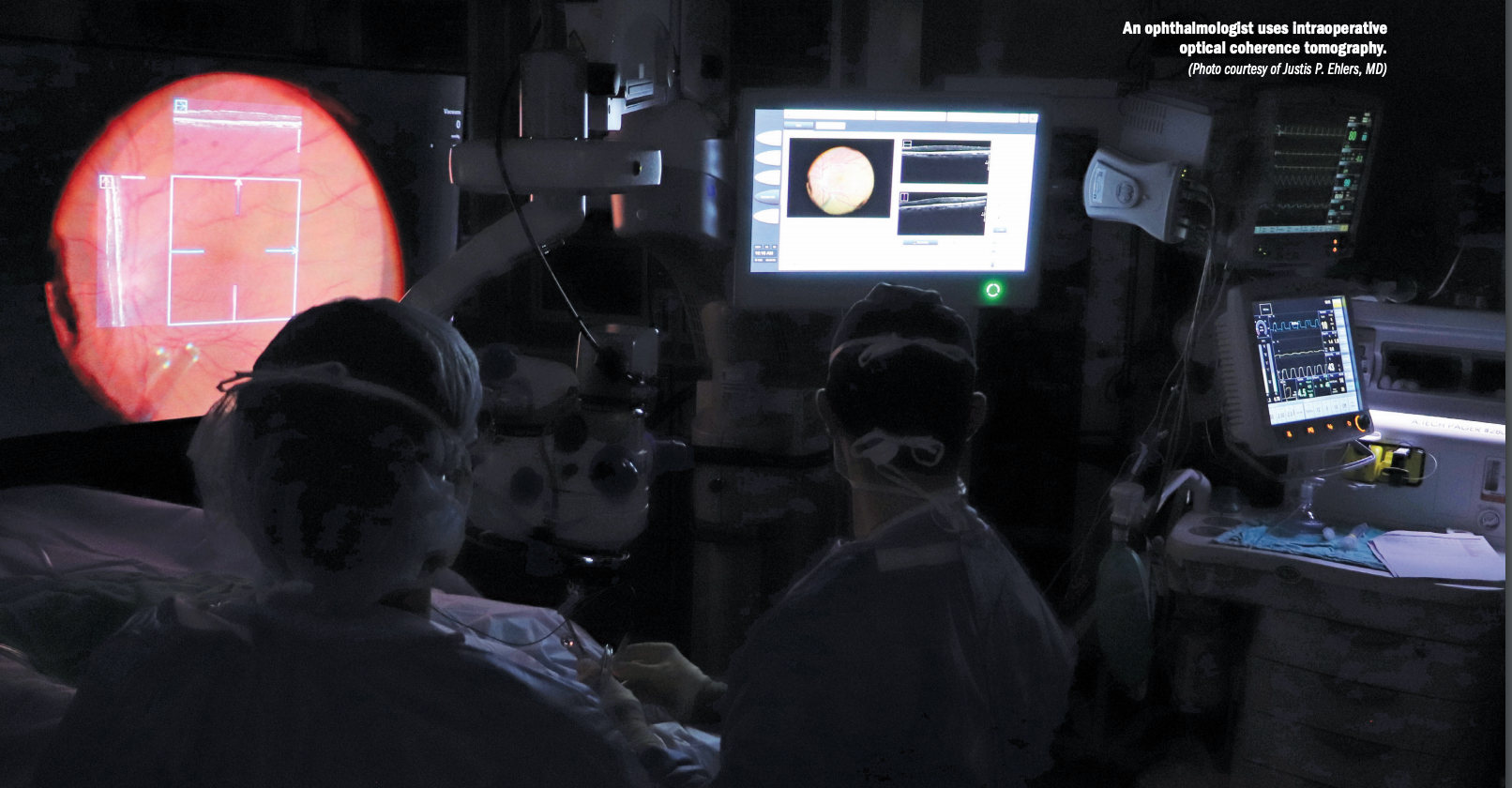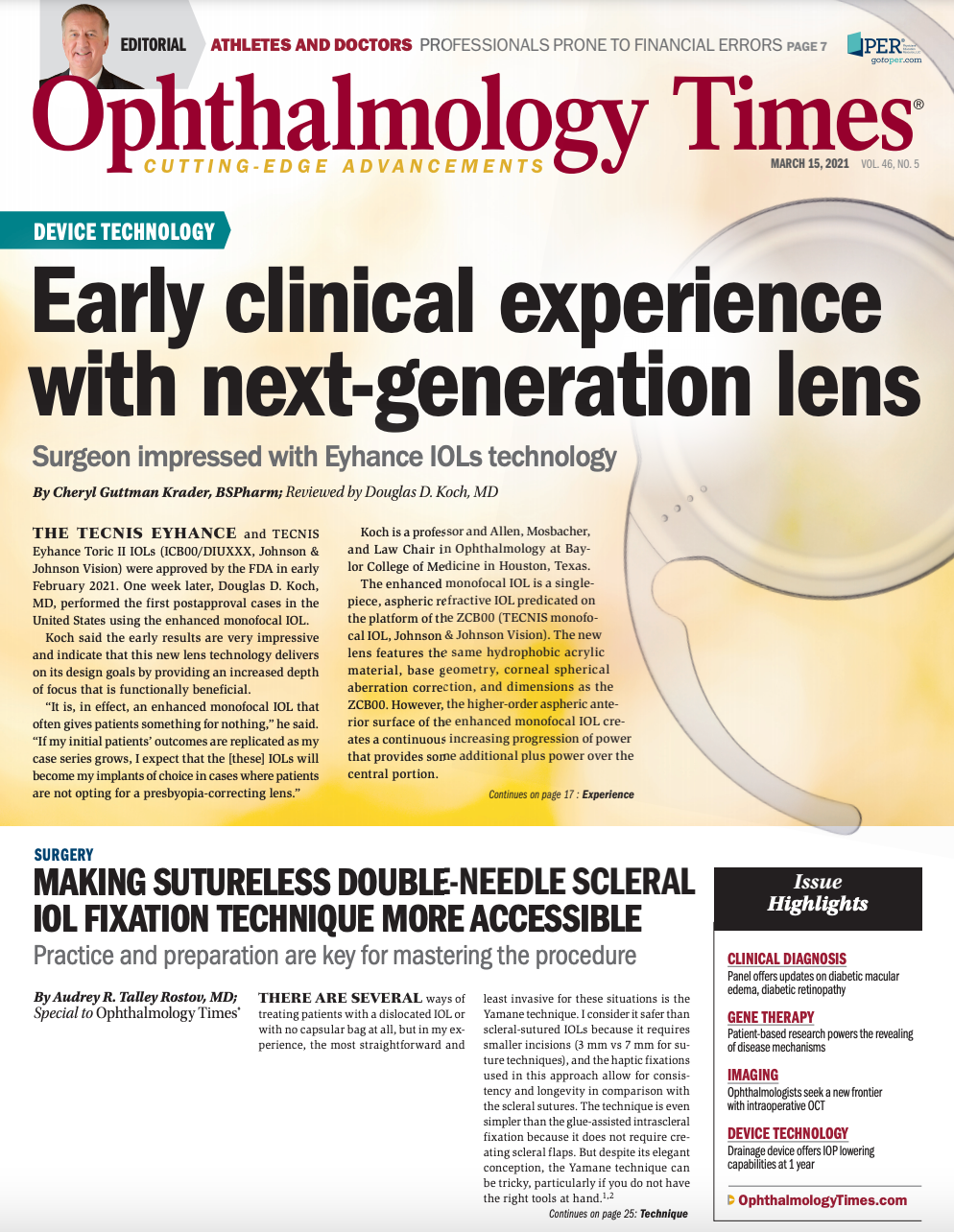Publication
Article
Digital Edition
Seeking a new frontier with intraoperative OCT
Author(s):
Advances in integrative technology enable a transition to the operating room.

This article was reviewed by Justis P. Ehlers, MD
Intraoperative optical coherence tomography (iOCT) is changing the landscape in surgical ophthalmic care.
The technology increases the understanding of ophthalmic disease, provides guidance for surgical decision-making, and continues to evolve with emerging improvements in visualization platforms and interactive surgical guidance, according to Justis P. Ehlers, MD.
Ehlers is the Norman C. and Donna L. Harbert Endowed Chair for Ophthalmic Research at Cleveland Clinic Cole Eye Institute and director of the Tony and Leona Campane Center for Excellence in Image-Guided Surgery and Advanced Imaging Research at Cleveland Clinic in Ohio.
Related: Visualization with en face OCT offers value for ophthalmologists
Microscope integration
This was the step that truly facilitated OCT’s use during surgery, a step that was pioneered by Cynthia Toth, MD, and Susanne Binder, MD. Ehlers noted that the systems with OCT integration have shown a strong correlation with the portable spectral-domain OCT systems.1
Multiple studies have demonstrated the potential value of a microscope-integrated OCT system.2,3
One prospective series of 40 surgical cases undergoing posterior segment surgery added to the body of information about iOCT in that additional information was provided by 74% of cases and the surgical decision-making was altered in 42% by the OCT findings.3
Ehlers explained that at the Cole Eye Institute, the DISCOVER study2 is evaluating multiple microscope-integrated iOCT platforms (eg, RESCAN 700, Carl Zeiss Meditec; EnFocus, Leica Microsystems).
Related: Noninvasive angiography with OCT offers definite value
Currently, the DISCOVER study has enrolled more than 2100 eyes. Specific areas of value that have been described include identifying membrane edges, confirming peel completion, and differentiating between partial- and full-thickness holes.
In addition, surgical decision-making was directly impacted in approximately one-third of cases based on iOCT feedback, including negating the need for adjuvant staining, identifying full-thickness holes, reducing unnecessary procedures, and targeting optimal chorioretinal biopsy sites, Ehlers said.
iOCT impact of intraoperative guidance
Given the significant role of OCT in the clinical diagnosis and characterization of vitreoretinal interface disorders, the impact of iOCT on membrane peeling is of particular interest.
Studies have demonstrated the discordance between surgeon perception and anatomic configuration.
This is true for identifying occult residual membranes when the surgeon believed all membranes had been removed (16%) and, conversely, confirming completion of surgical objectives when the surgeon believed there were still membranes to peel (20%).2
Related: Macular OCT imaging is vital in work-up of cataract surgery patients
Another potential advantage of using iOCT is the possible reduction in the need for intraoperative dyes and staining. One study found that in 40% of cases, membrane peeling could be performed without using dyes based on iOCT information alone.4
One example of where iOCT can be highly valuable is distinguishing between vitreoschisis and vitreomacular traction syndrome with underlying epiretinal membrane.
In these cases, it can be quite difficult to tell whether the underlying membrane on the retinal surface is removed with initial hyaloid elevation.
Using iOCT, a surgeon can receive immediate feedback following hyaloid removal or even during hyaloid removal to determine whether additional staining and/or peeling is required, Ehlers noted.
Related: Do you 'need' or just 'want' that new diagnostic imaging device?
“A helpful signal on iOCT is the identification of dual membranes during hyaloid elevation with concurrent elevation of the underlying membrane on the retinal surface,” he said.
The future
The “wish list” improvements to the technology include more rapid and efficient image acquisition, improvement in image quality and consistency, automated tracking to areas of interest, intraoperative software packages to aid in the understanding of the surgical maneuvers on the overall anatomic landscape, enhancements to the surgeon feedback platform, validation of outcomes and value, and the development of a reimbursement model, Ehlers noted.
There are a couple of areas Ehlers believes to be particularly exciting, including procedure-specific software.
Automated macular hole segmentation software allows visualization of the volumetric reconstruction of the holes, which allows surgeons to visualize the hole shape and contours.
Related: OCT: Illuminating the retina layer by layer
These parameters change after peeling of internal limiting membranes and may help predict how fast the holes will close.
Another exciting area is emerging iOCT-guided therapeutic delivery methods including retinal prosthesis, subretinal therapeutics, and stem cell and gene therapy.
Research is also being done in the area of iOCT-compatible instrumentation. Ehlers pointed out that a challenge of the current instruments is that the metallic design limits the ability to see the tissue-instrument interaction.
“Novel materials may help facilitate both simultaneous visualization of the instrument tip and the interaction,” he said.
The next-generation OCT engines may be key in the development of iOCT technology.
Related: OCTA a hope for diagnosing, managing ophthalmic diseases
High-speed prototype integrated OCT engines, such as those described by Toth and Joseph Izatt, PhD, enable real-time volumetric visualization of 3-dimensional (3D) conformational changes that occur with surgical manipulation.5
The goal is a new, integrative, digital surgical theater that includes an immersive surgeon experience with seamless utilization of iOCT during the surgical procedure. Visualization technology such as a 3D digital screen with iOCT overlay and simultaneous visualization of the underlying surgical field may prove helpful in this process.6
Ehlers concluded that the use of iOCT has been shown to impact surgical decision-making.
Related: OCT artifacts and pitfalls: In the eye of the beholder
“Significant advances in integrative technology have enabled this potential seamless transition of its use in the operating room, including FDA clearance of 3 integrated systems,” he said. “There are still unmet needs, including software advances, OCT-compatible instrumentation, automated tracking, and understanding the overall value to outcomes. New opportunities in the interactive landscape of surgical visualization include 3D digital surgery, robotics, and an OCT-enriched surgical theater.”
--
Justis P. Ehlers, MD
e:ehlersj@ccf.org
Ehlers is a consultant to Carl Zeiss Meditec, Leica, and Alcon. He also has intellectual property that is licensed to Leica.
---
References
1. Hahn P, Migacz J, O’Donnell R, et al. Preclinical evaluation and intraoperative human retinal imaging with a high-resolution microscope-integrated spectral-domain optical coherence tomography. Retina. 2013;33(7):1328-1337. doi:10.1097/IAE.0b013e3182831293
2. Ehlers JP, Modi YS, Pecen PE, et al. The DISCOVER Study 3-year results: feasibility and usefulness of microscope-integrated intraoperative OCT during ophthalmic surgery. Ophthalmology. 2018;125(7):1014-1027. doi:10.1016/j.ophtha.2017.12.037
3. Pfau M, Michels S, Binder S, Becker MD. Clinical experience with the first commercially available intraoperative optical coherence tomography system. Ophthalmic Surg Lasers Imaging Retina. 2015;46(10):1001-1008. doi:10.3928/23258160-20151027-03
4. Falkner-Radner CI, Glittenberg C, Gabriel M, Binder S. Intrasurgical microscope-integrated spectral domain optical coherence tomography-assisted membrane peeling. Ophthalmol Retina 2015;35(10):2100-2106. doi:10.1097/IAE.0000000000000596
5. Seider MI, Carrasco-Zevallos OM, Gunther R, et al. Real-time volumetric imaging of vitreoretinal surgery with a prototype microscope-integrated swept-source OCT device. Ophthalmol Retina. 2018;2(5):401-410. doi:10.1016/j.oret.2017.08.023
6. Figueiredo N, Talcott KE, Srivastava SK, et al. Conventional microscope-integrated intraoperative OCT versus digitally enabled intraoperative OCT in vitreoretinal surgery in the DISCOVER Study. Ophthalmic Surg Lasers Imaging Retina. 2020;5(4)1:S37-S43. doi:10.3928/23258160-20200401-05

Newsletter
Don’t miss out—get Ophthalmology Times updates on the latest clinical advancements and expert interviews, straight to your inbox.





